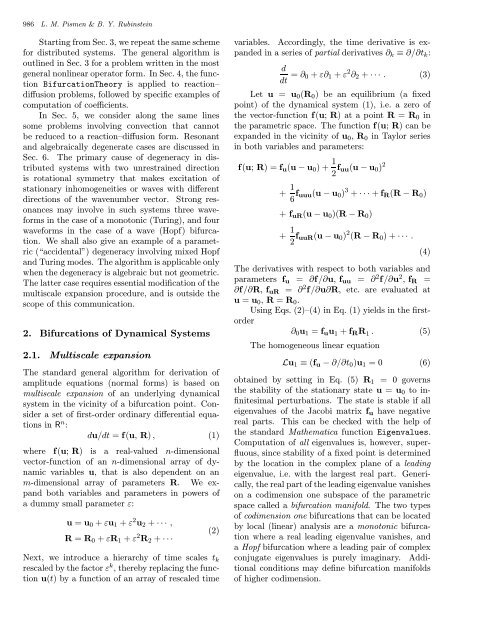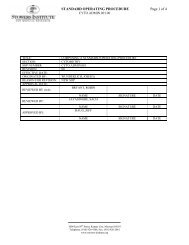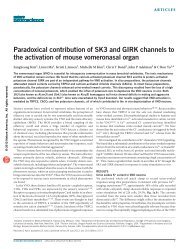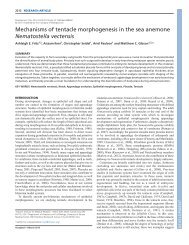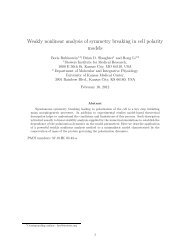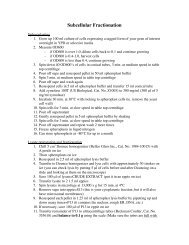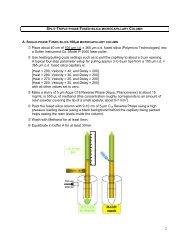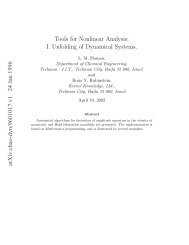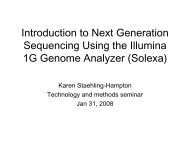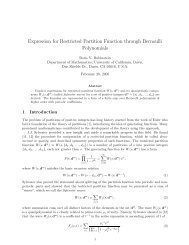Computer Tools for Bifurcation Analysis: General Approach with
Computer Tools for Bifurcation Analysis: General Approach with
Computer Tools for Bifurcation Analysis: General Approach with
Create successful ePaper yourself
Turn your PDF publications into a flip-book with our unique Google optimized e-Paper software.
986 L. M. Pismen & B. Y. Rubinstein<br />
Starting from Sec. 3, we repeat the same scheme<br />
<strong>for</strong> distributed systems. The general algorithm is<br />
outlined in Sec. 3 <strong>for</strong> a problem written in the most<br />
general nonlinear operator <strong>for</strong>m. In Sec. 4, the function<br />
<strong>Bifurcation</strong>Theory is applied to reaction–<br />
diffusion problems, followed by specific examples of<br />
computation of coefficients.<br />
In Sec. 5, we consider along the same lines<br />
some problems involving convection that cannot<br />
be reduced to a reaction–diffusion <strong>for</strong>m. Resonant<br />
and algebraically degenerate cases are discussed in<br />
Sec. 6. The primary cause of degeneracy in distributed<br />
systems <strong>with</strong> two unrestrained direction<br />
is rotational symmetry that makes excitation of<br />
stationary inhomogeneities or waves <strong>with</strong> different<br />
directions of the wavenumber vector. Strong resonances<br />
may involve in such systems three wave<strong>for</strong>ms<br />
in the case of a monotonic (Turing), and four<br />
wave<strong>for</strong>ms in the case of a wave (Hopf) bifurcation.<br />
We shall also give an example of a parametric<br />
(“accidental”) degeneracy involving mixed Hopf<br />
and Turing modes. The algorithm is applicable only<br />
when the degeneracy is algebraic but not geometric.<br />
The latter case requires essential modification of the<br />
multiscale expansion procedure, and is outside the<br />
scope of this communication.<br />
2. <strong>Bifurcation</strong>s of Dynamical Systems<br />
2.1. Multiscale expansion<br />
The standard general algorithm <strong>for</strong> derivation of<br />
amplitude equations (normal <strong>for</strong>ms) is based on<br />
multiscale expansion of an underlying dynamical<br />
system in the vicinity of a bifurcation point. Consider<br />
a set of first-order ordinary differential equations<br />
in R n :<br />
du/dt = f(u, R) , (1)<br />
where f(u; R) is a real-valued n-dimensional<br />
vector-function of an n-dimensional array of dynamic<br />
variables u, that is also dependent on an<br />
m-dimensional array of parameters R. We expand<br />
both variables and parameters in powers of<br />
a dummy small parameter ε:<br />
u = u 0 + εu 1 + ε 2 u 2 + ··· ,<br />
R=R 0 +εR 1 +ε 2 R 2 +···<br />
(2)<br />
Next, we introduce a hierarchy of time scales t k<br />
rescaled by the factor ε k , thereby replacing the function<br />
u(t) by a function of an array of rescaled time<br />
variables. Accordingly, the time derivative is expanded<br />
in a series of partial derivatives ∂ k ≡ ∂/∂t k :<br />
d<br />
dt = ∂ 0 + ε∂ 1 + ε 2 ∂ 2 + ··· . (3)<br />
Let u = u 0 (R 0 ) be an equilibrium (a fixed<br />
point) of the dynamical system (1), i.e. a zero of<br />
the vector-function f(u; R) atapointR=R 0 in<br />
the parametric space. The function f(u; R) canbe<br />
expanded in the vicinity of u 0 , R 0 in Taylor series<br />
in both variables and parameters:<br />
f(u; R) =f u (u−u 0 )+ 1 2 f uu(u − u 0 ) 2<br />
+ 1 6 f uuu(u − u 0 ) 3 + ···+f R (R−R 0 )<br />
+ f uR (u − u 0 )(R − R 0 )<br />
+ 1 2 f uuR(u − u 0 ) 2 (R − R 0 )+··· .<br />
(4)<br />
The derivatives <strong>with</strong> respect to both variables and<br />
parameters f u = ∂f/∂u, f uu = ∂ 2 f/∂u 2 , f R =<br />
∂f/∂R, f uR = ∂ 2 f/∂u∂R, etc. are evaluated at<br />
u = u 0 , R = R 0 .<br />
Using Eqs. (2)–(4) in Eq. (1) yields in the firstorder<br />
∂ 0 u 1 = f u u 1 + f R R 1 . (5)<br />
The homogeneous linear equation<br />
Lu 1 ≡ (f u − ∂/∂t 0 )u 1 =0 (6)<br />
obtained by setting in Eq. (5) R 1 = 0 governs<br />
the stability of the stationary state u = u 0 to infinitesimal<br />
perturbations. The state is stable if all<br />
eigenvalues of the Jacobi matrix f u have negative<br />
real parts. This can be checked <strong>with</strong> the help of<br />
the standard Mathematica function Eigenvalues.<br />
Computation of all eigenvalues is, however, superfluous,<br />
since stability of a fixed point is determined<br />
by the location in the complex plane of a leading<br />
eigenvalue, i.e. <strong>with</strong> the largest real part. Generically,<br />
the real part of the leading eigenvalue vanishes<br />
on a codimension one subspace of the parametric<br />
space called a bifurcation manifold. The two types<br />
of codimension one bifurcations that can be located<br />
by local (linear) analysis are a monotonic bifurcation<br />
where a real leading eigenvalue vanishes, and<br />
a Hopf bifurcation where a leading pair of complex<br />
conjugate eigenvalues is purely imaginary. Additional<br />
conditions may define bifurcation manifolds<br />
of higher codimension.


